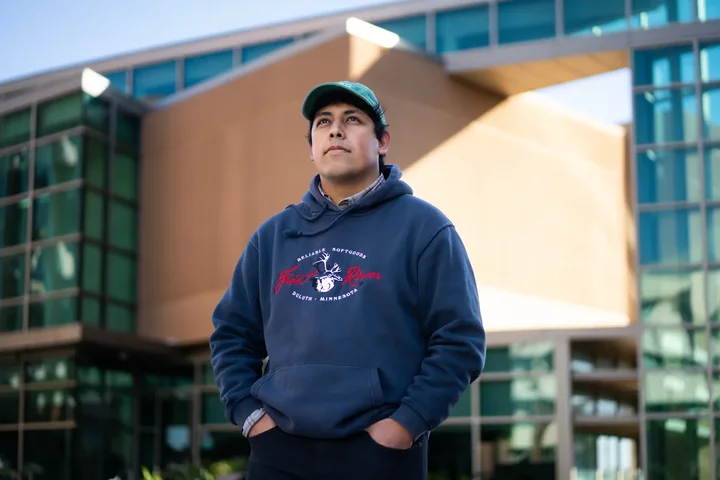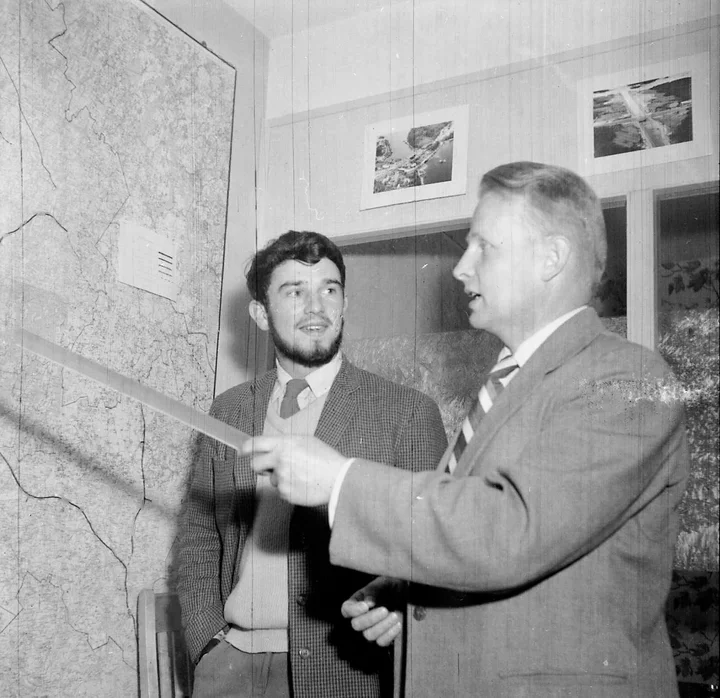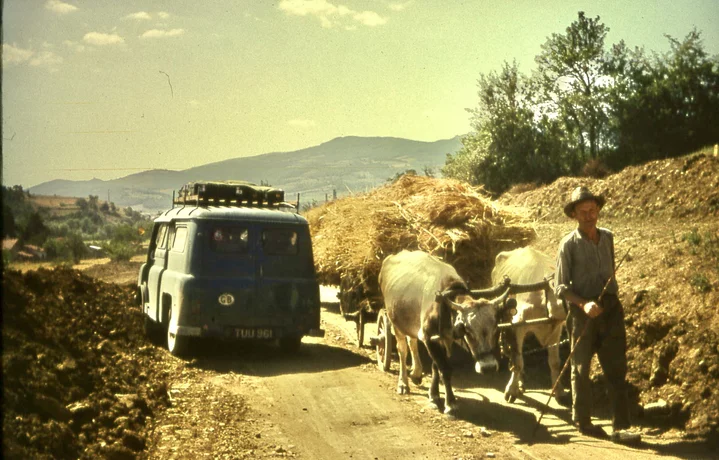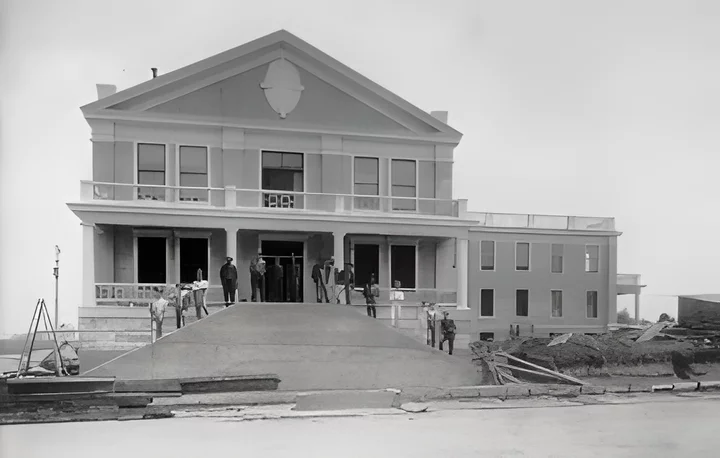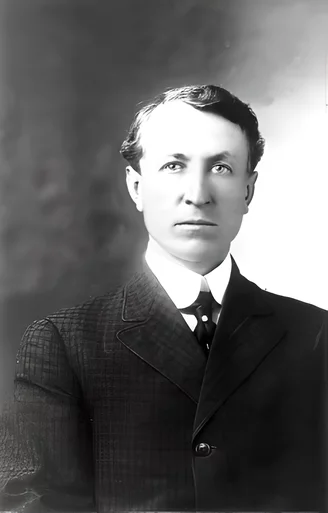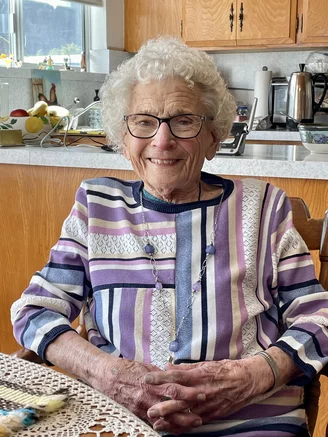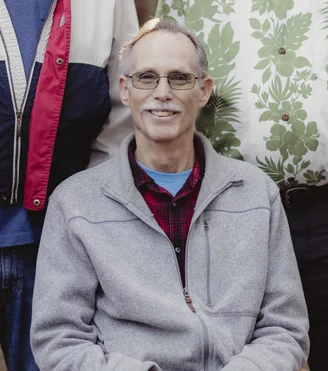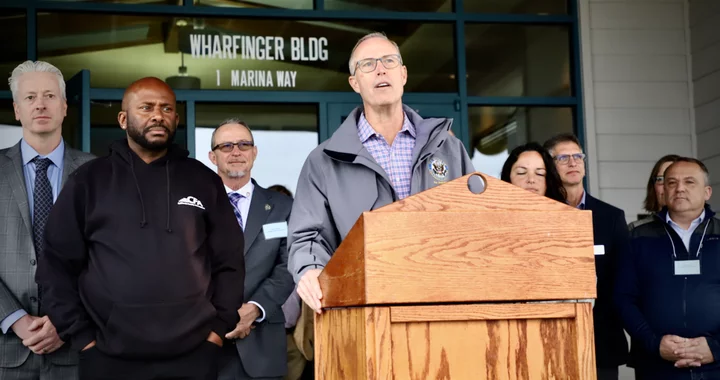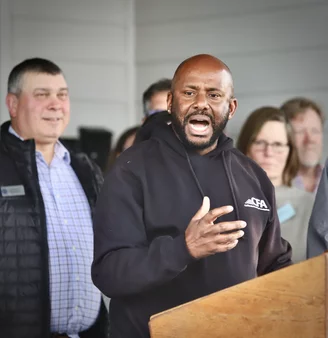‘Getting Significantly Worse’: California Community Colleges Are Losing Millions to Financial Aid Fraud
Adam Echelman / Monday, April 1, 2024 @ 7:05 a.m. / Sacramento
Martin Romero, a journalism major at East Los Angeles College in Monterey Park, said he was wrongly dropped from a class when financial aid fraud detection went awry. Photo by Jules Hotz for CalMatters
They’re called “Pell runners” — after enrolling at a community college they apply for a federal Pell grant, collect as much as $7,400, then vanish.
Since fall 2021, California’s community colleges have given more than $5 million to Pell runners, according to monthly reports they sent to the California Community Colleges Chancellor’s Office. Colleges also report they’ve given nearly $1.5 million in state and local aid to these scammers.
The chancellor’s office began requiring the state’s 116 community colleges to submit these reports three years ago, after fraud cases surged.
At the time, the office said it suspected 20% of college applicants were fraudulent. Because of the COVID-19 pandemic, the federal government loosened some restrictions around financial aid, making it easier for students to prove they were eligible, and provided special one-time grants to help keep them enrolled. Once these pandemic-era exceptions ended in 2023 and some classes returned to in-person instruction, college officials said they expected fraud to subside.
It hasn’t. In January, the chancellor’s office suspected 25% of college applicants were fraudulent, said Paul Feist, a spokesperson for the office.
“This is getting significantly worse,” said Todd Coston, an associate vice chancellor with the Kern Community College District. He said that last year, “something changed and all of a sudden everything spiked like crazy.”
Online classes that historically don’t fill up were suddenly overwhelmed with students — a sign that many of them might be fake — Coston said. Administrators at other large districts, including the Los Rios Community College District in Sacramento, the Mt. San Antonio Community College District in Walnut, California and the Los Angeles Community College District, told CalMatters that fraudsters are evading each new cybersecurity strategy.
The reason for the reported increase in fraud is because the chancellor’s office and college administrators are getting better at detecting it, he said. Since 2022, the state has allocated more than $125 million for fraud detection, cybersecurity and other changes in the online application process at community colleges.
The reports the colleges submitted don’t include how much fraud they prevented.
The rise in suspected fraud coincides with years of efforts, both at the state and local level, to increase access to community college. Schools are reducing fees — or making college free — while legislators have worked to simplify and expand financial aid. Those efforts accelerated during the pandemic, when community colleges saw record declines in enrollment.
It’s not surprising, then, that “bad actors” would take advantage of the system’s good intentions, Feist said.
Financial aid fraud is not new
College officials suspect most of the fake students are bots and often, they display tell-tale signs. In Sacramento, community colleges started seeing an influx of applications from Russia, China, and India during the start of the pandemic. Around the same time, administrators at Mt. San Antonio College saw students using Social Security numbers of retirees. Others had home addresses that were abandoned lots. Uncommon email domains, such as AOL.com, were another red flag.
These scams aren’t new. The federal government has long required colleges to report instances of financial aid fraud. Every year, the federal government closes around 40 to 80 cases, including a recent conviction of three California women who stole nearly a million dollars by collecting fraudulent student loans. California community colleges also say they’ve spotted fraudulent applications from people trying to get an .edu email address in order to receive student discounts.
“If I saw, for example, that a college that only gets 1,000 applications in some time frame gets 5,000, you kind of know something is probably up.”
— Valerie Lundy-Wagner, vice chancellor for the community college system
When the chancellor’s office began requiring community colleges to file monthly reports, it asked for the number of fake applications and the amount of money they gave to fraudsters.
CalMatters submitted a public records request for the data, broken down by campus. After the request was initially rejected, CalMatters appealed and received an anonymized copy of all of the monthly reports, lacking individual campus details.
The reports show that between September 2021 and January 2024, the colleges received roughly 900,000 fraudulent applications and gave fraudsters more than $5 million in federal aid, as well as nearly $1.5 million in state and local aid.
The numbers show that fraud represents less than 1% of the total amount of financial aid awarded to community college students in the same time period. It’s hard to tell how accurate the data is because compliance is spotty, with some months missing reports from as many as half the colleges.
More fraud, in more places
To understand how fraud is evolving, the chancellor’s office uses several sources of information and data, Feist said. One indicator is an atypical bump in applications.
“If I saw, for example, that a college that only gets 1,000 applications in some time frame gets 5,000, you kind of know something is probably up,” said Valerie Lundy-Wagner, a vice chancellor for the community college system.
The chancellor’s office provided CalMatters with anonymous application data for each month from September 2021 to January 2024. CalMatters analyzed the data using two different techniques to identify statistical outliers in the application data and asked the office to verify the methodology. The office repeatedly declined.

East Los Angeles College in Monterey Park on March 14, 2024. Photo by Jules Hotz for CalMatters
According to the analysis, more than 50 of the state’s 116 community colleges saw at least one unusual spike in the number of applications they received during that time frame. In the last year, colleges have seen more unusual spikes than at any point since 2021. Along with fraud, however, outliers could also reflect normal fluctuations in applications or the overall increase in college enrollment last year.
“What we’re hearing is that (fraud) is happening more widespread than people are letting on, but people just have their heads in the sand because it looks good to have your enrollment going up,” said Coston with the Kern Community College District. Many college administrators say improvements in artificial intelligence have made it easier for people to attempt fraud on a larger scale.
Yet clamping down too hard on fraud can have unintended consequences. More than 20% of community college students in California don’t receive Pell grants they’re eligible for. Administrative hurdles — including the verification process — are one reason why, according to a 2018 study by researchers at UC Davis. To help, the federal government is trying to simplify its financial aid application, but in some cases, it’s created more barriers for students during the rollout this year.
“We’ve overcorrected at times, even in policy, and in how stringently we’re verifying students relative to the amount of fraud in the system,” said Jake Brymer, a deputy director with the California Student Aid Commission. As a result, he said, real low-income students get pushed out.
Kicking real students out of class
Sometimes, the fraud detection backfires on actual students, ousting people like Martin Romero.
In order to graduate from East Los Angeles College, Romero, 20, must take American history, so last fall he enrolled in an online class where students can watch pre-recorded lectures on their own time.
He said it’s all he had time for. Romero takes four classes at East Los Angeles College each semester and serves as its student body president. He also helps out at his family’s auto body shop, sometimes as much as 15 hours a week.
On the first day of class last fall, he said the online portal, Canvas, wasn’t working on his computer.
That day, the American history professor did a test through Canvas, asking students to respond to a prompt in order to prove they were not a bot. Romero didn’t answer, so the professor dropped him from the class.
“I was freaking out,” he said, and wrote to the professor as soon as he found out, begging to be reinstated. The professor told him the class was already full again, so letting him in would mean kicking someone else out.
“We’re frustrated with the fact that some of these courses are getting filled really quickly. We see it as an access issue for our students.”
— Leticia Barajas, Academic Senate president at East Los Angeles College
For the college’s Academic Senate, the faculty group that governs academic matters, fake students is one of the top three issues, said its president, Leticia Barajas.
“We’re frustrated with the fact that some of these courses are getting filled really quickly,” she said. “We see it as an access issue for our students.”
She said there’s been an uptick in recent months, especially in certain kinds of online classes, that has forced professors to focus on hunting bots instead of teaching. Professors now are expected to test their students in the first weeks, asking them to submit answers to prompts, sign copies of the syllabus, or send other evidence to prove they are real.
Increasingly, she said, the bots are evading detection, especially with the help of AI. “They’re submitting assignments. It’s gibberish,” she said.
The endless, multi-million dollar game of combating fraud
Campus and state officials described fraud detection as a game of whack-a-mole. “When we get better at addressing one thing, something else pops up,” said Lundy-Wagner. “That’s sort of the nature of fraud.”
To fight fraud, she said, the chancellor’s office, the 73 independently governed districts and their colleges all must work together, including those who oversee information technology, enrollment and financial aid. Part of the challenge is that the system is so “decentralized,” she said.
The largest reform underway is a new version of CCCApply, the state’s community college application portal, which will offer more cybersecurity, Feist said. He also said there are other “promising” short-term projects.
One of them, a software tool known as ID.Me, launched in February. The contract with the software company, costing more than $3.5 million, gives it permission to check college applicants for identification, including video interviews in certain cases. Privacy experts have warned that the company’s video technology could be racially biased and error-prone.
To mitigate these privacy concerns and avoid creating enrollment barriers, applicants need to opt in to the new verification software.
In the first few days after its implementation, 29% of applicants opted in to ID.Me’s new vetting process. Some applicants started the verification process but never finished, said Feist, while others are ineligible because they’re under the age of 18. The rest chose not to verify their identity for other reasons, including many who are suspected bots.
‘We’re just trying to survive’
In Los Angeles, community colleges have already seen a drop in suspicious applications, said Nicole Albo-Lopez, a vice chancellor with the district. But she’s skeptical the problem is solved. “The lull we see, I don’t believe we’ll be able to sustain,” she said. “They’ll find another way to come in.”
Her district is now concerned that bots are trying to steal data or intellectual property, not just financial aid. “Say I have 400 sections of English 101 online. There are 400 variations of readings, assignments, peer-to-peer questions that somebody can go in and scrape,” Albo-Lopez said.
Barajas said faculty at East Los Angeles College are so overwhelmed by bots they haven’t discussed the potential risk to their intellectual property: “We’re at such a level where we’re just trying to survive.”
Meanwhile, students like Romero who are wrongly mistaken for bots must develop their own survival skills. When the professor denied the request to re-enroll, he signed up for the same course in the one format that was still available — in-person. The class met every Monday and Wednesday at 7:10 a.m., and the professor deducted points for anyone who was late.
“It was torture,” he said, noting that he missed two classes and was late to around four. He finished the class with a B but said he would have had an A if he had gotten into the class he wanted.
As student body president, he said he’s been outspoken about the issue. While he was able to fulfill his history requirement, he worries that other students may not be so lucky.
###
Data reporter Erica Yee contributed to this reporting.
Adam Echelman covers California’s community colleges in partnership with Open Campus, a nonprofit newsroom focused on higher education.
CalMatters.org is a nonprofit, nonpartisan media venture explaining California policies and politics.
BOOKED
Yesterday: 7 felonies, 9 misdemeanors, 0 infractions
JUDGED
Humboldt County Superior Court Calendar: Friday, Dec. 5
CHP REPORTS
0 Us101 (HM office): Trfc Collision-No Inj
1600 Mm36 E Hum 16.00 (HM office): Closure of a Road
ELSEWHERE
RHBB: Arcata Fire District Updates Board Meeting Schedule Beginning January 2026
Times-Standard : Protest violations result in formal warning for Cal Poly Humboldt student activist
GROWING OLD UNGRACEFULLY: Travel, Then and Now
Barry Evans / Sunday, March 31, 2024 @ 7 a.m. / Growing Old Ungracefully
I’d just hitch-hiked from Helsinki, capital of Finland, to the town of Mikkeli, where I’d been assigned a student-exchange gig for the local “TVH” (Ministry of Works) during my summer university break. It was a Sunday afternoon, offices closed. Not knowing a word of Finnish beyond “good morning,” I walked into a drugstore, thinking — correctly as it turned out — that people whose business was pharmaceuticals might speak some English. When I asked about a budget hotel, a kindly assistant took pity on me, telling me, in English, to come back in an hour when she was off work. Soon I was eating dinner with her and her family, later sleeping on their couch. Next morning I found my way to the Ministry of Works office (where I promptly acquired the name “Musta parta,” black beard). These days, my iPhone would have taken care of me, but at what price of innocence?
“Musta parta” with my temporary Finnish boss, 1962. (Barry Evans)
That was 1962. Every so often when Louisa and I are traveling, a small incident reminds me of the difference between then and now — essentially how much easier it is now. For instance, last night, reading a Kindle book on my 7-ounce iPhone, I remembered carrying three heavy books in my bike panniers through the mountains of Spain in the ’80s.
Let me count some of the other ways that makes traveling in 2024 a cinch compared with back then.
Money
Remember Travelers’ Checks (Amex) or Travellers’ Cheques (Thomas Cook)? We were reminded of these two popular types in Sri Lanka 40 years ago, when I tried to cash some Cook’s cheques (bought in the UK a month previously) in Nuwara Eliya, at the town’s only bank. “Sorry sir, we only handle American Express. You have to go to Kandy for Thomas Cook.” Two half-days of traveling later, I returned triumphant, rupees in hand. Nowadays, a debit card from any US bank will be accepted at virtually all ATM machines the world over. Oh yeah, and now you can use euros in most of Europe, no changing currency at borders.
Maps
I’m a Queen’s Scout (the UK original version of an Eagle Scout), so map-and-compass went with the territory, so to speak. Anyone who has cycled in France knows the satisfaction of using Michelin 1:100,000 paper maps: stick to the yellow roads (the ubiquitous paved back roads) and you’ll be fine. Today, of course, Google will plot your route, after you’ve told it (her?) whether you’re on foot, on a bike or driving. Even — the ultimate in magic — what time a bus or train leaves for your destination, including where and when to change.
Driving on the main west-east road through Bulgaria in 1963. (Barry Evans)
Booking
That’s booking.com for us. In the old days, we’d arrive — on foot, bike or bus — not knowing where we’d spend the night. True, we never lacked for accommodation, despite some close calls (pitching a tent in the courtyard of an Athens hotel, a haystack in Finland), but the sheer luxury of arriving somewhere, tired (often wet) and knowing there’s a room already reserved has no equal. In Mexico, where traveling in long distance buses reminds us of flying business class, booking seats in advance online is so handy.
Uber
— and its many clones. How many times has Uber saved our asses, from flying into Gatwick (UK) at 2 a.m. to getting back to our hotel from a remote Roman ruin an hour away in Bulgaria? There’s a downside to the ease of summoning Uber: hitch-hiking was easier back then. We still do it, despite being advised not to (in Lebanon, every driver who picked us up gave us a lecture on why. we shouldn’t hitch there!), but somehow the casual, carefree ease of hitching — someone would always pick us up — seems to have gone the way of steel-frame bikes.
Communications
Aerograms! Telegrams! Telex! Phone booths! General delivery/Poste restante! Need I say more?
In 1960, you could stay in a (very basic) Scottish Youth Hostel like this for three shillings (about $3 today). (Barry Evans)
Everything is so much easier for a traveler these days, and, at my age, I appreciate it all. And yet…I miss the self that figured out how to find an English speaker in a small Finnish town, the self that drove to Istanbul in a funky van with five other students while waiting for the results of our finals, the self that hitched half the width of Scotland with a collapsed bike wheel.
Gotta go, I have to check the online bus timetable and book seats.
THE ECONEWS REPORT: How Do Fish Get Counted, and Why Does Genetic Diversity Matter?
LoCO Staff / Saturday, March 30, 2024 @ 10 a.m. / Environment
Photo: NOAA Fisheries.
This week on the EcoNews Report we discuss how fish are monitored and counted. Our host Alicia Hamann from Friends of the Eel River is joined by Dave Kajtaniak from the California Department of Fish and Wildlife and Samantha Kannry from TRIB Research. Tune in to learn about the hopeful returns salmon returns on the Eel and why preserving genetic diversity is so important to giving species the adaptability they need to survive our changing climate.
HUMBOLDT HISTORY: Shocking Scenes in the Surgery! Following Verbal Set-To Over Zonked-Out Patient, Fisticuffs Fly Between Physicians Falk
“Louella Parsnips” / Saturday, March 30, 2024 @ 7:30 a.m. / History
Charles C. and Curtis O. Falk established the Northern California Hospital, at the corner of Trinity and F Streets, Eureka, shown here under construction, circa 1906. It later became St. Joseph’s Hospital.
###
ED. NOTE: Suzanne Forsyth, former editor of the Humboldt Historian, was delighted to find herself channeling the pseudonymous voice of “Louella Parsnips” —an ill-reputed, scandal-hungry gossip monger who right-thinking society people publicly abjure — for these pieces of true history.
###
In November of 1911, two respected Eureka physicians, the brothers Charles C. and Curtis O. Falk, got into an explosive argument, leading soon after to a second encounter resulting in the hospitalization of the older brother, Charles C. Falk. This is shocking, but there is more: the initial shouting match between the brothers had broken out in a hospital operating room in the midst of an operation they were performing, as their patient, with his insides exposed, lay anesthetized upon the table. Not even the creators of our modern medical dramas on TV have conjured such a scene, at least to my knowledge, and should they ever do so—should, for example, the Doctors McDreamy and McSteamy of one popular TV series ever get in a fight while performing surgery — remember you saw it first in the Humboldt Historian.
Members of the celebrated Falk family, which locally produced entrepreneurs, doctors, lawyers, and judges over several generations, Charles and Curtis Falk began their professional partnership with high ideals. In 1906, they established the Northern California Hospital, one of the most state of the art facilities in the West. Located at the corner of Trinity and F Streets, the Falk brothers’ hospital incorporated “all the modern ideas and scientific principles, such as ventilation, sanitation, light and heating,” was open to “all reputable physicians” and the general public, and was a registered training school for nurses. Insurance was offered to Humboldt’s laboring men — primarily woodsmen, whose dangerous work brought many calamities — in the form of yearly and semi-yearly certificates.1
Charles C. Falk, the older brother, was the president of the hospital, and his younger brother Curtis was the secretary. In surgery, Charles generally wielded the scalpel, with Curtis attending. Reader, you may now begin to surmise the source of their discord, for it was none other than that oldest and most powerful engine of discontent, jealousy. My informant reports:
It is understood that the ill feelings [had first] cropped out in the form of petty jealousies. It began with Charles getting the credit for difficult operations in which he was assisted by Curtis. It would be said that so-and-so was operated upon by Dr. Charles Falk assisted by Dr. Curtis Falk. Sometimes it would be the reverse. One would win honors which the other deserved, or at any rate was gathering the glory.2
These jealousies may have festered for some time, may even have had their roots in childhood rivalries, but the first outward sign that the brothers’ relationship was not just in trouble, but approaching detonation, was in the operating theater of the brothers’ hospital, and in the presence of several friends and associates of the Falks who had been invited to witness the operation. My informant was among them.
Charles was performing the surgery, with the younger Curtis assisting, and the operation had progressed to the point where Charles was explaining to those present a certain method he had for stitching such cases. Suddenly, Curtis could take no more. In the words of my informant:
Curtis, becoming tired of playing a minor part, then and there took off his rubber gloves and remarked something about being tired of working with such a braggart, inferring that Charles was using the opportunity to win more laurels.3
Bursting with resentment at his brother’s allegations, Charles countered by announcing his intention to sever their partnership, asserting that he would come up with a figure by which Curtis could become the sole proprietor of the hospital.4
All those in attendance were stunned and the Falk blowup immediately became the talk of the town. As to the patient who had lain on the operating table waiting to be stitched up as his doctors squared off, I can offer no report. It seems this fellow was completely forgotten about during his operation, and in the aftermath as well.
The incident was still fueling gossip when Eurekans were treated to yet another scandal, for the flare-up in the operating room was but the prelude to a full-blown knock-down drag-out, which took place two weeks later in Charles’ offices in the Connick and Sinclair building on F Street between Fourth and Fifth. There were no eyewitnesses this time, but several reliable citizens in adjoining offices heard the brothers’ voices and the noise and put the story together. It is said that Charles had now come up with his figure and submitted a proposal to Curtis to purchase the hospital. Curtis declared the figure exorbitant and said Charles named it because he knew it was prohibitive.
My informant gleaned the following account of the altercation from those present in the building:
Language conducive of violence entered into the discussion and soon the brothers were locked in combat. The younger but larger Curtis, who weighs about 185 or 186 pounds, is said to have caught Charles by the throat and brought his free hand around with a mighty blow that sent his older brother, who weighs about 148 or 150 pounds, sprawling on the floor. Charles tried to put up a resistance, the reports say, by making a fight to protect himself in his own office. His resistance was met by other blows and soon the smaller man was completely down and out. He is reported to have asked Curtis if he (Curtis) was going to kill him (Charles), but about that time became unconscious. When he came to his senses again, Dr. E. C. Glatt, a dentist with adjoining offices, was standing at this side, and Curtis was a little distance away in the same room.5
Word got out that Charles was worsted in the fight, his injuries such as to require hospitalization and the constant care of a nurse. My informant, who visited Charles several days after the encounter, reports that he still carried the marks of his brother’s fingers upon his neck.6
Of course, as everyone knows, stories in the streets regarding this incident got a bit out of hand. For example, while it is true that Charles’ pistol was almost within reach, my informant reports that “authentic sources say no attempt was made to use it, and that all reports on the streets about gunplay are unfounded.”7
If the citizenry focused on the Falk feud as the most riveting topic of the day and even let their imaginations run away with them, the Falk brothers themselves were utterly silent on the subject. When pressed by my informant, both men were evasive. Charles said he didn’t want to talk about it, but did acknowledge that he and his brother would have separate offices in the future. Curtis would only state that he was severing his connection with the Northern California Hospital. About the report that the two men had engaged in a physical altercation, both men merely waved it off with a laugh.
As my informant recalls:
Both tried to make light of such reports; both declined to make any statement about what led up to their separation.
In spite of all that had happened between the two men, it does not appear that a lasting separation between the brothers actually occurred, either personally or as business partners in their hospital. Indeed, Curtis was in his brother’s care when he suffered a typhoid infection in the spring of 1918,8 upon recovering from which he joined Charles in the battle against the Spanish influenza epidemic.9 The Northern California Hospital remained open throughout most of 1918 to care for flu patients, closing only when both Charles and Curtis joined the US Army Medical Corps in November of that year.10
After the Army, the Falk brothers each returned to private practice.11 Perhaps they did not want to tempt the gods of ignition by trying the partnership route again. Personally, however, I like to imagine that the brothers did not long deprive the townspeople of some thrilling recrudescence of their rivalry. And so I am putting the pair’s lively misconduct at the top of my list for “Best Medical Melodrama” of early 1900s Eureka.
Before partnering with his brother Charles to build the Northern California Hospital, Curtis O. Falk was a founder of the Sequoia Hospital at 6th & H Streets, Eureka, shown here circa 1908.
###
ACKNOWLEDGEMENTS
Many thanks — and, yes, a time-travel expense account — to my man about town, Rory Hedger.
###
NOTES
- Humboldt Standard, May 10, 1911 (Advertisement).
- Humboldt Standard, Friday December 29, 1911.
- Ibid.
- Ibid.
- Ibid.
- Ibid.
- Ibid.
- Humboldt Times, April 6, 1918.
- Humboldt Times, November 16, 1918.
- Humboldt Times, November 8, 1916.
- The Falk brothers sold their hospital in 1920 to the Sisters of St. Joseph of Orange, who renamed it St. Joseph Hospital, which continues to this day.
###
The story above was originally printed in the Spring 2012 issue of the Humboldt Historian, a journal of the Humboldt County Historical Society. It is reprinted here with permission. The Humboldt County Historical Society is a nonprofit organization devoted to archiving, preserving and sharing Humboldt County’s rich history. You can become a member and receive a year’s worth of new issues of The Humboldt Historian at this link.
OBITUARY: Gloria DeZordo, 1926-2024
LoCO Staff / Saturday, March 30, 2024 @ 6:56 a.m. / Obits
Gloria DeZordo was born in San
Francisco in 1926 to Ines and Settimo Casini, both immigrants from
Italy.
Gloria grew up in South San Francisco, the middle child with two other sisters, Adelma and Lola. Her father and uncle had a truck farm from which they supplied produce to high-end grocers in San Francisco. In her childhood, Gloria spent many hours on the farm. She later went to work first as a clerk at the local Sprouse-Reitz store and then at a bakery and a children’s store, where she made many friends.
In 1945, she married Dini DeZordo. They made their first home in South San Francisco, but always visited Ferndale and the many friends they made here. Dini had been coming to Ferndale since he was 18 years old and his friends included the George Scalvini family. He and Gloria purchased property long before they moved to Ferndale, confident their dream of living here would come true.
In 1968, they built their house on Rose Avenue and settled into life in Ferndale. Because of all the years of visiting and the friends they had made, they felt like they were home. Gloria began working as a lunch lady at Ferndale Elementary. She has many found memories of the students she met, including a young Guy Fieri (Ferry). Gloria remembered Guy pushing his pretzel cart to town and she always said she knew that young man was going somewhere.
In 1996, she began an eleven-year career as a volunteer in the kindergarten at Ferndale Elementary. Gloria became known as Grandma to hundreds of kindergarteners. Often, adults would come up to her and say “Hi Grandma” – another grown-up kindergartener remembering her hugs and encouragement. Gloria lived independently in her own home on Rose Avenue.
Gloria is survived by her sister Lola Clark, daughter Nadene (DeZordo) Bass and Jim Bass, Lydia DeZordo and Mike Goldsby. She was Nonie to Regina Byrd, Megan Goldsby, Phillip Bass and Orrin Goldsby. She was great grandmother or “Other Nonie” to Hayley Byrd, Jayden Byrd, Vincent Bass, Luci Bass, Elio Goldsby, and Rae Goldsby and was looking forward to a new great granddaughter in September. She is also survived by numerous nieces and nephews.
She was preceded in death by her husband Dini DeZordo, sister Adelma Baker and her parents.
Gloria was a great cook but most famous for her biscotti. Even though she would share her recipe, her biscotti were always better. She loved entertaining for the holidays and hosted Christmas dinner for years. She enjoyed her Saturday coffee time with her neighbor John Filipini and desserts with her neighbor Sandra Siddall.
Gloria will be greatly missed by all who knew and loved her. A celebration of life will take place on Saturday, April 20, at 3 p.m. at the Veterans Memorial Building in Ferndale. Donations can be made to your favorite charity.
###
The obituary above was submitted on behalf of Gloria DeZordo’s loved ones. The Lost Coast Outpost runs obituaries of Humboldt County residents at no charge. See guidelines here.
OBITUARY: Kenneth ‘Ken’ Glen Stuart Robertson, 1958-2024
LoCO Staff / Saturday, March 30, 2024 @ 6:56 a.m. / Obits
On Tuesday,
February 20, 2024, Ken lost a short but aggressive battle with Stage
4 advanced lung cancer. He passed peacefully at St. Joseph hospital
surrounded by his family.
Ken was born March 3, 1958 and adopted by Dr. Andrew and Josephine “Penny” Robertson. He became the younger brother to Andrew. Their father was in the Navy during the Korean War. They lived in the Marshall Islands (Kwajalein) as well as Hawaii before returning to Eureka. They moved to Walker Point road. That was where life really began for the boys. Ken made many life long friends in the neighborhood. In the early days of moving to the neighborhood, the family dog came up missing. That was when Ken met his lifelong best friend, James Ballew, and they may have found themselves in a bit of trouble from time to time.
Ken had his first job in high school as a delivery driver for a local pharmacy, Ritchie Woods. He then became a Certified Mechanic at Isaacson Motors. After that, Ken had many more delivery jobs. He worked for Heuer’s Florist as a delivery driver and always smelled so good after work. Then as a driver for his father in-law’s pizza parlor, Blue Max Pizza. He then returned to delivering pharmaceuticals for three local pharmacies: Redwood Pharmacy, Lima’s Pharmacy and Cloney’s pharmacy. And that was where he belonged — it gave him both the joy of driving as well as helping others, which were two of Ken’s favorite things to do. So many customers turned into friends. He was known for going above and beyond to help the older ladies make up weekly med boxes as well as driving over at 6 a.m. on their trash days to take the can out for them.
April 19, 1984, Ken and Ellen welcomed their baby girl, Courtney, into the world. She was the light in his life. Ken spent five years in Salinas, California before returning home to Eureka. At that time he had lost touch with his daughter. But in the last few years he was able to reconnect with her. This last year was when they really found the chance to connect and it was so beautiful to witness their reunion.
Ken met his wife Linda Willams-Ballew in 1978. At the time, she was married to his friend James. But life has a funny way with things and fast forward to 1993 they started dating. On September 14, 1996 Ken and Linda were married. Ken now had two new stepdaughters, Amy and Leslie. They enjoyed many camping trips and a family vacation to Montana together. He loved to travel. Especially to the many NASCAR events he attended, but To the Edge Music Cruises really warmed his heart. Most of the time, Ken could be found tinkering on something or working in the yard. He was always busy in the yard, whether it was planting the seasons bulbs or just mowing. He was also known to be a sucker for a stray. Ken brought home countless puppies and kittens “in need” and never turned away a stray or rescue . He was very passionate about his NASCAR. That is what you would find him at home watching every Sunday, February through November. He had a love for Ford vehicles and everything about the sky. Whether it was the clouds or the stars he could talk about them for hours. He could tell you when a satellite or Starlink was going to pass and would text to tell you to go outside to see it. He was very passionate about everything in life. He always had a smile on his face and a go-getter attitude. Even on his worst days he put on that well-known smile and made the best of things.
In 2021 Ken finally had a hit with his ancestry DNA test. He had a match to a maternal cousin. With the help of a genealogist he was able to find some information on his birth family. He had reunited with his daughter and had contact with some of his birth family. Ken had stayed in contact with his sister Millie Haecherl, although he never got to meet her in person. Having been able to reconnect with his daughter and family, Ken’s life was complete.
Ken is survived by his wife of 27 years, Linda Willams Ballew Robertson; his daughter, Courtney Robertson; step-daughters, Amy Thallheimer (Mike) and Leslie Pollace (Krysti) and bonus daughter, Dara Lawson; his brother, Andrew Robertson; brother-in-law, Jim Williams (Lyn); grandchildren Michael Thallheimer, Robert Brennan, Bradley Brennan and Payton Pollace; nieces and nephews Andrew Robertson (Katee), Patricia Robertson, and Tami Williams as well as many great-nieces and nephews. Ken was preceded in death by both his parents, Andrew Robertson and Josephine “Penny” Robertson, as well as his sister, Helen “Rose” Robertson; mother and father In-laws, James “Jim” Williams and Becky Williams.
There will be a Celebration of Life, Sunday, April 28 at 2 p.m. in the afternoon at the Fortuna Volunteer Fire department. 320 S.Fortuna Blvd. Fortuna , 95540. The family asks that you wear your favorite flannel, Hawaiian shirt, band tee or NASCAR apparel. Please bring your memories for the memory box (both good or bad) the family will appreciate all memories and stories of Ken.
In lieu of flowers, please make donations in his name to the Sequoia Humane Society or a charity of your choice.
###
The obituary above was submitted on behalf of Ken Robertson’s loved ones. The Lost Coast Outpost runs obituaries of Humboldt County residents at no charge. See guidelines here.
After Meeting With Local Tribes, Congressman Huffman Doubles Down on Offshore Wind
Isabella Vanderheiden / Friday, March 29, 2024 @ 4:36 p.m. / Infrastructure , Offshore Wind
Congressman Jared Huffman (center) held a press conference at the Wharfinger Building in Eureka Friday to discuss the latest surrounding offshore wind development on the North Coast. Photos by Andrew Goff.
###
Offshore wind development efforts are full steam ahead here in Humboldt.
That was the message sent by Congressman Jared Huffman during a press conference at Eureka’s Wharfinger Building this morning. Surrounded by more than a dozen local, state and federal stakeholders, Huffman voiced his enthusiastic support for offshore wind and port development on the North Coast, touting the anticipated economic boon that comes with it.
“I’ve been representing this area for 12 years in the United States Congress and I have heard every manner of dream scheme plan to revitalize the economy,” he said. “None of it really holds together in a way that delivers the benefits and possibilities that this offshore wind project does. This [project] is incredibly responsive to the needs of this region, state and nation.”
Over the next decade, the Humboldt Bay Harbor, Recreation and Conservation District hopes to transform its Marine Terminal II property — formerly home to the Samoa pulp mill — into a state-of-the-art industrial site to support floating offshore wind farms all along the West Coast.
“As exciting as all those possibilities are, I think we’re also very clear-eyed that it’s not easy; it’s complicated,” Huffman said. “In some ways, we are creating an entirely new industry and … we want to help California – the fifth largest economy in the world – to meet these essential climate goals. This project is a very important part of that, and we want to do it in a way that honors our marine environment, that lifts up working people with good quality union jobs.”
And at the “front and center” are tribal values, Huffman said, acknowledging the recent surge in tribal opposition to offshore wind development on the West Coast.“We need to make sure that this works for Indian Country in a way that, historically, some economic opportunities have not. There’s a history of disappointment and exploitation, and we are determined to get this right for our tribal partners.”
As of this writing, five local tribal councils have adopted resolutions formally opposing the proposed offshore wind project, citing “grave concerns” about potential risks to marine ecosystems and the sustainability of industrial-scale renewable energy.
U.S. Secretary of the Interior Deb Haaland and Acting Secretary of Labor Julie Su visited the North Coast earlier this week to hear tribal concerns surrounding offshore wind. Asked to elaborate on the outcome of the discussions, Huffman said local tribal leaders “expressed a variety of views,” ranging from “enthusiasm” to “really grave concerns.”
“I think it was a frank exchange of views that are not a monolith,” he said. “I think that we did a lot of listening and heard them, but I didn’t hear anything that I believe is in any way insurmountable. I think we can realize all of the upside of this incredible opportunity while making it work for tribal nations in a way that previous waves of economic development have not. And I know that the intention to do that is here and it’s sincere.”
Huffman was joined by 65th District Assemblymember Mike Gipson, Chair of the Select Committee on Ports and Goods Movement, who discussed how the Port of Humboldt Bay fits into a greater “offshore wind industrial complex” slated for the West Coast.
“I have spent the last eight months touring all up and down California, touring our ports, meeting with surrounding communities and I must admit: Humboldt, you have been second to none,” Gipson said. “Your hospitality [and] your engagement far transcends this moment. … You lead the way in making [this] happen, and I believe others will follow.”
While out at dinner last night, Gipson said, he had the opportunity to speak with a few local folks about offshore wind development and the potential benefits of the project. “And they said, ‘We want jobs. Not only jobs – we want to make sure the people who live here get the jobs first,’” he said. “When I was a local leader of the [Carson] City Council, a big department store was coming to our city, and I said that I expect 85 percent of those jobs to be found for people who live in my community. How can I feed my neighbor’s kids, if my own kids are going hungry? … We hear you. We see you. We support you.”
Dozens of local, state and federal stakeholders attended this morning’s press conference, including Gov. Gavin Newsom’s Senior Advisor for Offshore Wind Jana Ganion, Director of Initiatives at Cal Poly Humboldt Connie Stewart, Humboldt County Supervisor Natalie Arroyo, Eureka Mayor Kim Bergel, harbor district and county personnel, representatives from the major international firms investing in offshore wind, among others.
###
CLARIFICATION: This article has been changed from its original version to include additional context from Asm. Gipson regarding local jobs.
###
PREVIOUSLY
- Harbor District Announces Massive Offshore Wind Partnership; Project Would Lead to an 86-Acre Redevelopment of Old Pulp Mill Site
- Offshore Wind is Coming to the North Coast. What’s in it For Humboldt?
- ‘Together We Can Shape Offshore Wind for The West Coast’: Local Officials, Huffman and Others Join Harbor District Officials in Celebrating Partnership Agreement With Crowley Wind Services
- Crowley — the Company That Wants to Build a Big Wind Energy Facility on the Peninsula — Will be Opening Offices in Eureka
- Harbor District to Host Public Meeting Kicking Off Environmental Review of Offshore Wind Heavy Lift Marine Terminal Project
- Humboldt Harbor District Officials Talk Port Development As Offshore Wind Efforts Ramp Up
- County of Humboldt, Developers Sign Memorandum of Agreement in a ‘Momentous Step Forward’ for Offshore Wind Development on the North Coast
- Harbor District Responds to Crowley Controversy, Commits to the ‘Highest Ethical Standards’
- LoCO Interview: The Outpost Talks to Crowley Executives About Recent Allegations of Misconduct, Port Development on the Samoa Peninsula and the Company’s Future in Humboldt
- Harbor District Board of Commissioners to Discuss Proposed Offshore Wind Terminal Project, Lease Agreement With Crowley During Tonight’s Meeting
- (UPDATE) Huffman Announces $8.7 Million Federal Grant Toward Offshore Wind Port Development
- Harbor District Commissioners to Discuss Extended Partnership Agreement with Crowley Wind Services During Tonight’s Meeting
- WHOA: Rep. Huffman’s Office Teases $426 Million Federal Grant for Offshore Wind Terminal, to be Announced Tomorrow
- (PHOTOS) The Biggest Federal Grant in Humboldt History? Huffman, Assorted Worthies Gather on Woodley Island to Celebrate $426 Million in Infrastructure Funding for Offshore Wind
- At a Two-Day Conference in Eureka This Week, North Coast Tribes Advocate for ‘Meaningful Engagement’ With Offshore Wind Developers, Federal Regulators
- Yurok Tribal Council Votes to Formally Oppose Floating Offshore Wind Energy Projects Along North Coast
- Bear River Tribal Council Joins Yurok in Formally Opposing Offshore Wind Development Along North Coast
- Trinidad Rancheria Becomes Latest Tribal Entity to Register Opposition to Offshore Wind
- Federal Officials, Developers Call for Collaboration with North Coast Tribes Amid Growing Opposition to Offshore Wind Development

